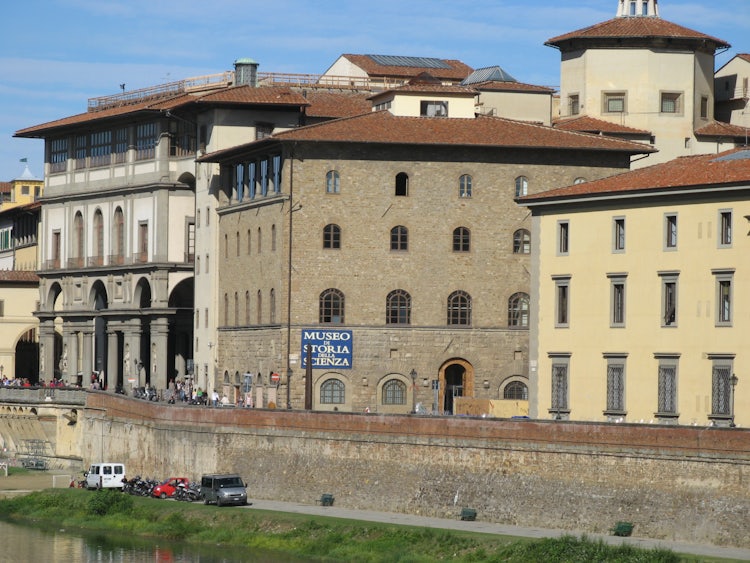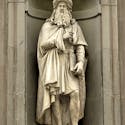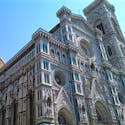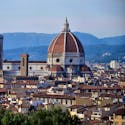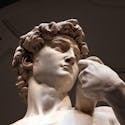Once called "the ancient circle" by Dante in the year 1078
As you begin to explore the squares, monuments and churches of Florence, it is virtually impossible to not encounter the remains of the city “walls” and “doors”. As you wander the historical center, your attention will be drawn to what is sometimes a physical reminder of stone walls and arches and sometimes it will just be the name of the street which recalls what once surrounded the area.
The walls were responsible for protecting the growing city and were an important piece of its first defence: sometimes 10 meters high with guard towers every 100 meters, surrounded by a moat from a local river and drawbridges to small urban areas just outside the protective ring. When you follow these traces, you get a different perspective of Florence as it grew over the years.
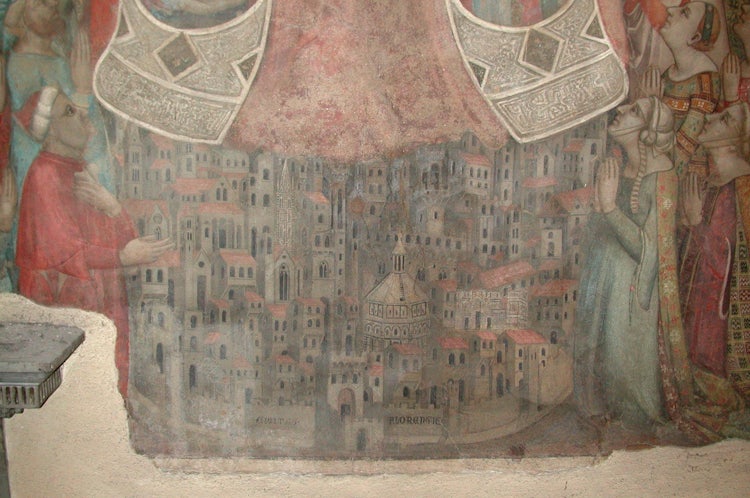
Though there is some discussion on exactly how many times Florence rebuilt its walls (4 or 6?), for the purpose of our exploration we will concentrate on the walls from the year 1078, named “La Cerchia Antica” by Dante.
Below we give you not just a path to follow, but a few tidbits of info that may help you imagine how the walls and doors have been absorbed into modern architecture, and hopefully just enough history to tease you into visiting some of the wonderful museums in Florence which will help you fill in the missing pieces of the puzzle that the walls present.
La Cerchia Antica
between Charles the Great and Countess Matilde di Canossa
When seen from above, it is easy to see the impact the Roman imprint had upon the construction of the city walls. Straight lines follow the ancient Roman buildings, which over time have been transformed into homes and municipal buildings during the reign of Charles the Great (early 800’s) and then later by the impressive female ruler, Countess Matilde di Canossa (late 1100's).
The expansion of the new walls stretched towards the Arno river, to encompass the growing population and defensive castles. The instability of the land and the health hazards of living too close to the water made it so that the Arno river was not included in the city walls - but the walls were built close enough so that the busy ports had easy access to the city.
ex-Santa Reparata
From here you will have Santissima Annunziata to your back and you will be looking upon the mammoth marble covered structure which wasn’t even in the planning stages when the first city walls were constructed. What used to stand here was known as the church Santa Reparata. It was among the largest early Christian complexes of Tuscia, which is the name the Romans gave the territory under Etruscan influence before they incorporated them in their reign.
On my tour of the Duomo included a visit to the Crypt of the older church (Santa Reparata), where we had a glimpse of what was left of the walls (buried underground now) that bordered right along the far north wall.
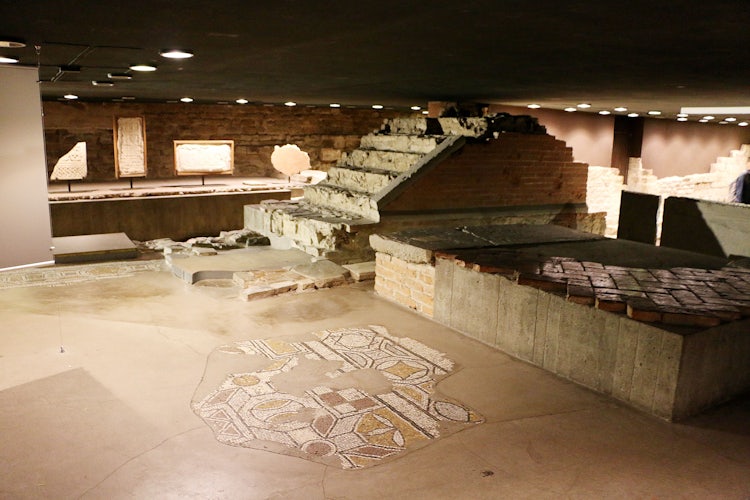
Santa Maria Maggiore
Some say this church was founded in 580 by Pope Pelagio, though there is nothing to confirm this claim. However, we do have documents from the years 931, 1028 & 1078 that demonstrate that it was already standing before the final walls were built. There are numerous legends that surround this church, but not one of them actually is dated at the time of the wall.
I would be remiss, however, if I let you walk right by without at least mentioning one of my favorites stories: the face of Berta, (as the Florentines call her.) Her petrified face adorns the bell tower in white marble (look up and search the wall). She apparently taunted and teased a man condemned to death, who then cursed her provoking the petrifaction of her face... she was doomed to never to leave the tower.
Mugnone
The river Mugnone once ran along the walls, and served as a defensive moat. This river is no longer visible in the heart of Florence, but only because its route has been artificially changed several times throughout the centuries. There is lasting proof of its passage here, just look at the street name, in fact the name via Panzani (the road that runs towards the train station) comes from the word “pantano” a word that means “land with low and stagnant water, mud and slime.”
At one time, the Mugnone river wrapped itself around the city walls and emptied into the Arno river close to where we find Ponte Vecchio. The river was deviated and later included in Fortezza da Basso which once had a bridge to cross its tumultuous currents.
Via Tornabuoni
At one time this was the outline of the city's Roman walls and then later, in the early Middle Ages, this road ran along the Mugnone river. The name Tornabuoni came much later; in this period, it was called Via Larga dei Legnaiuoli and Via dei Belli Sporti. Today, it passes along the prestigious Palazzo Strozzi, known as one of the finest examples of Renaissance domestic architecture and Florence's largest temporary exhibition space hosting modern and contemporary art shows.
The fact that it is a popular shopping street came much, much later. As you walk down this road, I encourage you to engage in a bit of window shopping... and maybe even some real shopping!
Porta di San Brancazio
The Gate of San Brancazio is actually a distortion of the name San Pancrazio and the nearby monastery that held his name. The church is now the home to the Marino Marini Museum, an intriguing mix of historic and modern art and a great little corner of tranquility and quiet. You won’t find any physical reminders of the gate, but you can imagine it standing just about where the current Palazzo Strozzi sits which is more or less where the antique Roman gate once stood.

Santa Trinita
Originally this historic and sombre church was on the outside of the walls, but in 1172 it was incorporated within the “Matilde Walls”. If you have the time to take a look inside, you can see pieces of the original structure, before the restyling in Gothic. Read our article for more information on this church.
In the square, you will find a column carved from oriental granite, the only one found in pristine condition when they cleaned up the Caracalla thermal spa and the Roman natatio (pool) in Rome. It was gifted to the Medici family by Pope Pio IV and crowned with a statue of Justice.
Palazzo Buondelmonti
The history of Florence can easily be retold walking these walls, and one of the more gory stories would involve the Buondelmonti family. This building started as a tower-house called “torre degli Scali” and changed name several times over the years. The fight between the Guelfs and Ghibellines was already in full swing at the time of the wall, however it was the events that took place nearby here that made it swell into a battle that would guide the politics of Florence into modern times.
Coined by the character Robert Langdon in Dan Brown’s Inferno as “Florence’s bloodiest murder”, Buondelmonte de’ Buondelmonti’s death is said to have taken place 1216. The suitor was killed by the Amidei family after Buondelmonte broke his engagement to marry a woman in the family, in order to marry another woman. His murder exacerbated divisions between the Guelfs and Ghibelline factions in Florence, a conflict which continued for several decades.*
Santissimi Apostoli
This church stands on the outskirts of what was once part of the Roman city (via delle Terme is only one street over and refers to the Roman thermal baths). And if you are inclined to believe any of the legends that surround the church it was a major player not only during the Romans reign but also during Charlemagne's rule (also known as Charles the Great), and even during the Crusades and Michelangelo. Read more about this church.
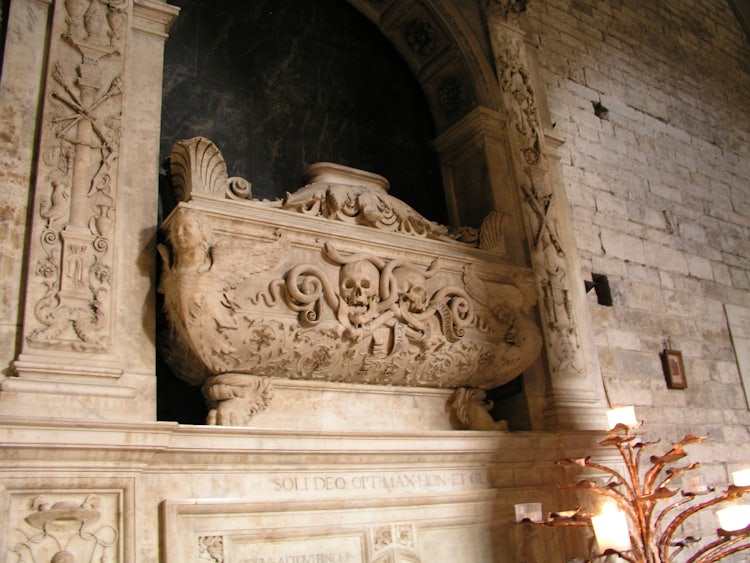
Uffizi
The building before you now didn’t come along until the late 1500’s, so if you want to see what was here before you need to walk over to via della Ninna, where you can see the remains of the church of San Pier Scheraggio on the external wall of the Uffizi, while the central nave is part of the exhibition area of the museum.
For many locals, the name "via della Ninna" comes from a painting by Cimabue (Madonna della Ninna). It was thought that the Madonna was singing the baby Jesus to sleep in the painting. The phrase "ninna nanna" in Italian means "lullaby," thus the word ninna has stayed with us and the road is called via della Ninna - or the lullaby road. However, this is only one theory. To see and read more of this church, read here. Head back toward the Arno to continue the itinerary.
Arno River
The Arno river is a life line that flows through Florence. This river has its origins in the Apennine mountains at the top of Casentino valley. It makes its way south towards Arezzo before turning north again, and was one of the major road ways for economic growth bringing wool, wood and more from the valley and the monks that lived there. Though it was also a source of destruction with the various floods that have overwhelmed its banks, the latest in 1966, the Arno River is certainly a point of reference in the city. This area at one time was an important commercial port for the Arno River.
Castello d’Altafonte, the Galileo Museum today
The Castello d’Altafronte, once a fortified residence, was destroyed by the 1333 flood. Rebuilt as a private residence, this building had several roles until it finally became the home to the Galileo Museum. One of its many roles was the home to the Giudici di Ruota (magistrates or judges of the high court of the Grand Duchy) as well as housing the collections of manuscripts owned by the Biblioteca Nazionale for a while.
The restoration of the basement in 2002-2003, exposed four massive stone foundation arches of the ancient Castello d'Altafronte. Today, the museum of the history of science features the tools used by Galileo himself.
Palazzo Vecchio
At this point you are walking past the back of Palazzo Vecchio, which among the many things to visit includes the Roman digs underneath the building. Here you will see remains of the ancient Roman city and amphitheater.
Badia Fiorentina
This is the last stop before meeting up with the starting point at the Duomo. Though many concentrate on the Duomo as the main church in Florence (and rightly so, it is magnificent!) - there are a few others that existed before the current Duomo: San Lorenzo, for example, and the Badia Fiorentina, which was built in 978 by Willa, Countess of Tuscany, in commemoration of her husband. This last one is recognized as one of the main buildings still standing from medieval times in Florence.
The original abbey stood at the edge of the first city walls and faced a different direction from the present building, with its façade to the west and three apses to the east.
Today, in front of Bargello you will find two metal circles embedded in the road. These mark the spot where, during an archaeological dig, they found the remains of the tower along the city walls... from when Florence was a Roman colony! The excavations date those walls, and thus the foundation of the colony, to the years 30 and 15 B.C.
As you continue to walk around the city of Florence, keep a lookout for any signs of the ancient walls that surrounded the central park of the city. They are occasionally easily noticed, yet many times, through the passage of years, they have become hidden within newer architecture and live on only in stories and legends. Our itinerary hopes to point out some of the signs remaining so that you can experience some of the earliest history of Florence.
Another way to visit the city? Follow our itinerary that follows the steps of "Inferno" , Dan Brown's book.
